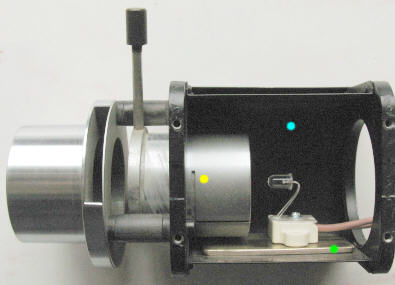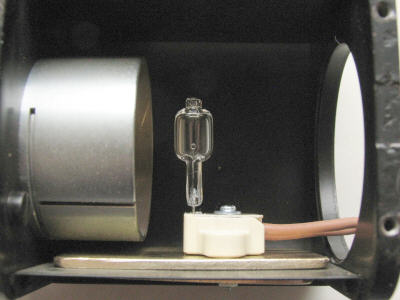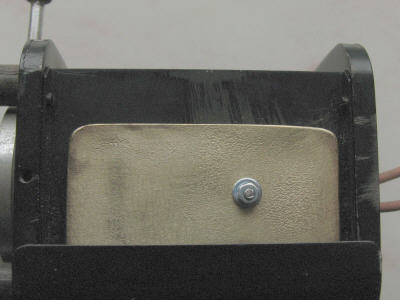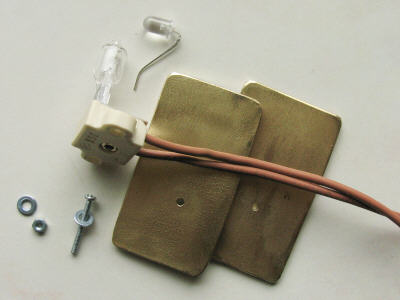| A Simple Halogen/LED
Lighting Source Modification
A Very Basic Yet Practical Alteration for the Novice or Seasoned Microscopist By Paul James |
One of the merits of modern light sources has turned out to be their relative simplicity in mounting, aside much lower costings. I thought I'd post a few notes and images of a recent effort of mine to 'upgrade' a Leitz Dialux's lamphouse with a modern light source, which it is hoped will demonstrate how simple it can be to anyone wishing to do this.
Although the Leitz's original lamp holder with a refined inbuilt alignment adjusting module was extremely well engineered, I decided to remove it because the LED/Halogen light sources were so compact that they could be mounted within the lamphouse condenser housing. This meant I could dispense with the entire lampholder assembly which would effectively halve the lamphouse's original length, and it got rid of the thick mains power cable I disliked.
During the course of upgrading it soon became obvious that the new halogen lamp's base unit would just as easily support an LED bulb, and so the making of a new lamphouse light source proved to be more useful than I originally planned. It would I thought be a very useful way of comparing the merits of either light source with the same 'scope.
Placement and fixing the bulb's base holder proved simplicity itself. All I had to do was to bolt 2 metal plates one either side of the lamphouse bottom casing and mount the holder on the upper plate. The hole in the floor of the lamphouse through which the bolt passed was made sufficiently large to allow considerable fore/aft/lateral adjustment of the bulb filament when setting up Kohler illumination. When nipped the bolt held fast the 2 plates without movement. The filament's height needed to be on the optical axis of the illumination system, and this was conveniently realised by having a 2 mm top plate thickness beneath the bulb holder. The lamphouse condenser lens is housed in a focussing unit which isn't strictly necessary since the LED/Halogen bulb can be adjusted anyway.
 |
The image shows an LED light bulb in place in the halogen base holder in the lamphouse which has its side removed for illustration purposes. The bending and shaping of the 2 wire leads was very easy and any subtle alignment required to bring it onto the optical axis was also easily achieved whilst observing the field through the phase telescope. On the down side, the replacement of either a halogen or LED bulb would require the holder to be unbolted and removed because of the lack of finger friendly work space, but I considered this to be a small inconvenience.
 |
This image shows the intended halogen 12volt 20 watt bulb in place. Note the 'end on' position of the internal filament revealing its close proximity to the bottom of the glass envelope. Fortunately the angle of light output subtended from it was just sufficient to fully illuminate the whole of the lamphouse's condenser without dead spots.
 |
The under plate is shown above which ensures the mechanical stability of the light source by virtue of its large contact area. The 'kit' as seen below is exceedingly simple. The only critical aspect is the overall dimension of the plates which must allow some fore/aft/lateral motion within the lamphouse to make the focussing of the bulb easily achievable. Of course an approximate idea of the actual position of the light source is required before thinking about plate dimensions and bolt hole location etc..
 |
Loose Ends
I've left the rear end of the lamphouse open for the time being until I know which light source I'll use in the long term. One particular constraint imposed by the use of an LED is its relatively shallow angled light output. This translates into it not being able to fill the entire lamphouse condenser with light in some cases. Thus the field will be narrower than expected, and might also not fully fill the backlens of the condenser and so reduce its full aperture potential. In low power use the field can be broadened by inserting a ground glass screen just below the condenser. It works very effectively for all but the most critical situations.
The LED source has the distinct advantage of only requiring a couple of AA cells to power it. Therefore 2 batteries plus the switch and relevant resistors can be mounted inside the lamphouse with a little thought and deft assembly. Ideal for those compound 'scope users on the move.
This sort of DIY mini project ends the dreaded "Where do I get a replacement bulb from ? " scenario in a stroke !
| All comments welcome by the author Paul James |